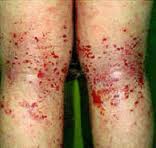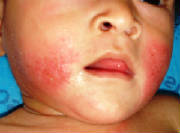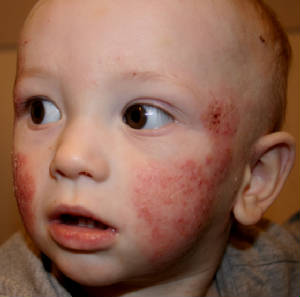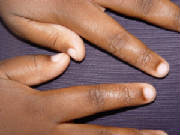Atopic Dermatitis (Eczema)
Atopic dermatitis (AD) is a chronic skin disorder that that causes dry, itchy, and inflamed skin. The rash of AD comes and goes in cycles. The worsening of AD (“flares”) can be brought on by a variety of triggers.
AD is very common, affecting 10-15 percent of people. It is not contagious. However, the severe itching and irritation during flare-ups can be extremely bothersome and even painful. The rash can also be unsightly.
Fortunately, most cases respond well to treatment.
The term “eczema” is sometimes used to describe atopic dermatitis. Eczema refers to inflamed, itching skin from a variety of causes. Atopic dermatitis is the most common type of eczema.
The appearance of AD varies tremendously from person to person. Most people with AD experience a short-term flare for a few weeks (acute), during which the skin looks red, raised, and cracked. Between flares, the skin may appear normal or slightly dry. If the rash lasts a long time (chronic), the skin may start to change appearance, becoming thicker and darker. These patches of thickened skin take longer to respond to treatment
What Causes Atopic Dermatitis?
The exact cause of AD is unknown, but the tendency to develop AD runs in families. People with atopic dermatitis
are more likely to suffer allergies and/or symptoms of asthma. The connection between these disorders appears to be an overactive
immune system.
T-cells, a type of white blood cell that fights infections, appear to be more active in people with AD. Changes beneath the skin make the skin of people with AD more susceptible to losing water quickly, leading to dry, cracked skin.
Although the immune system is overactive in people with AD, it is not always effective at fighting infections. In fact, people with AD are more susceptible to skin infections, such as impetigo.
What
Are the Signs and Symptoms of Atopic Dermatitis?
The most obvious symptoms of AD are intense itching,
along with red, dry skin that is sometimes scaly.
Infants - Children less than one year old often have AD widely distributed over their body. The skin is usually dry, scaly, and red. The baby may scratch the skin, leading to scratch marks. The cheeks of infants are often the first place to be affected. The diaper area is frequently spared because the moisture retained by the diapers prevents the skin from drying.
____________________________________________________________________
Toddlers - As children reach 2 to 3 years old, AD becomes more localized to areas such as the outer part of the joint, including the front of the knees, outside elbows, and top of the wrists. Older children are also more capable of a vigorous scratch, creating very red and inflamed areas.
____________________________________________________________________
School-age
children
As children reach school age, AD tends to migrate to the part of the joint that flexes,
such as the insides of the elbows and knees. AD may also start to appear on the eyelids, earlobes, neck, and scalp. School-age
children may develop itchy blisters on the fingers and feet known as dyshidrotic or vesicular dermatitis (pompholyx).
____________________________________________________________________
Adults - Adults with AD tend to have the rash localized to specific areas, particularly the hands, feet, eyelids, back of the knees, and insides of the elbows. However, the skin elsewhere on the body may feel dry and prone to itching.
Atopic dermatitis that starts in infancy often improves by the time the child is 5 years old and usually resolves by the teenage years. However, many people endure atopic dermatitis and need to manage it throughout their lives.
What Are the Treatment Options for Atopic Dermatitis?
The goals of AD treatment
are to heal the skin, prevent new flare-ups, and reduce the urge to scratch, which can further irritate and prolong symptoms.
AD treatment may last for many months, and treatments often need to be repeated.
There are several treatment options available. Your doctor will recommend a treatment plan based on several variables, including:
- Your age
- Location (face vs. knee)
- Severity
- Acute vs. chronic (long-lasting symptoms may require more potent medications)
- Results of past treatments
- Your personal preferences
Treatment mainstays include trigger avoidance and frequent moisturizing.
Additional treatment options include:
- Topical corticosteroids
- Topical immunomodulators (Elidel, Protopic)
- Antihistamines
- Antibiotics
- Oral corticosteroids (prednisone)
- Immunosuppressants (cyclosporine)
Moisturizers and AD
One of the most important
steps for treating and managing AD is to use a moisturizer. Moisturizers provide a layer of protection from irritants, trap
moisture in the skin, help restore the skin barrier, and improve the skin’s appearance.
Regular use of a moisturizer may reduce the need for other medicines.
Moisturizers are best applied at least twice a day within 3 minutes after a bath, shower, or swim.
When choosing a moisturizer, look for a hypoallergenic and ointment-based product. Thicker moisturizers will protect the skin longer than lighter lotions. Avoid moisturizers containing alcohol, fragrances, or other chemicals that can irritate the skin. Even seemingly harmless substances like glycerin can dry the skin of people with AD.
Possible moisturizers include:
- CeraVe
- Cetaphil
- Eucerin
- Aquaphor
- Vaseline Petroleum Jelly—-though thick, it is quickly absorbed by very dry skin
Before applying the moisturizer, use tepid water and a gentle cleanser to remove dead skin cells. Do not scrub or rub excessively. Apply the moisturizer immediately afterward while the skin is still damp.
Remember to use plenty of moisturizer to keep AD at bay, especially in children. Keeping a child’s skin sufficiently moisturized could require as much as 1-2 bottles of moisturizer per week. Adults will need even more.
Topical corticosteroids
Topical corticosteroids
are commonly used to calm the irritation from an AD flare. They are available in various strengths, with “super potent”
being the strongest. The more potent, the greater the risk of side effects. Mild or acute cases of AD usually respond well
to mild steroids. Severe or chronic AD, with skin thickening, or on the palms or soles, may require more potent steroids.
If topical steroids are used for too long or inappropriately, they can cause side effects such as thinning of the skin, or become absorbed into the blood.
Use only mild steroids on delicate areas like the face, groin, underarms, and genitals. Potent formulations should only be used for a few weeks at a time and never on wounds or skin that is thinned from overuse. Potent steroids should be used with special care in children.
In general, moderate-to-potent steroids are recommended for use on thick lesions for a limited time.
Topical immunomodulators (Elidel, Protopic)
Topical immunomodulators
(TIMS), or calcineurin inhibitors, are a type of medication applied to the skin that can help control the symptoms of AD and
reduce the need for topical steroids. They are a useful alternative for sensitive locations, such as the face and skin folds.
They are generally effective and well tolerated.
There are currently two FDA-approved topical immunomodulators for treating AD: Elidel (pimecrolimus) and Protopic (tacrolimus). Both work by reducing inflammation and other symptoms of AD. These medicines have fewer side effects than topical corticosteroids, but it has been theorized that they may lead to an increase risk of skin cancer.
This risk is not fully known and is still being evaluated. You can read a full statement from the National Eczema Association (NEASE) here.
Antihistamines (Benadryl, Atarax)
Oral antihistamines help reduce
the itching and scratching that can further damage the skin. They are often recommended for use at night to help prevent scratching
during sleep, and some people find them too sedating for use during the day.
Antibiotics
Bacteria, such as staph, can live on the surface of skin without causing any problems. However, at times, these bacteria
can trigger AD flare-ups or prevent inflamed skin from healing.
Topical antibiotics are useful because they can be applied directly to an inflamed area. However, an oral antibiotic, such as cephalexin or erythromycin, may be recommended if larger areas are inflamed or appear infected,
Oral corticosteroids
Short
courses of oral corticosteroids, such as prednisone, may help control a severe case quickly. Risks of this treatment include
a rebound of symptoms and side effects such as dizziness or fatigue. The medication is usually limited to a few weeks and
the dosage is often tapered off.
Immunosuppressive drugs
When AD
fails to respond to any other therapies, immunosuppressive drugs may be recommended to calm the immune system. These include
cyclosporine, methotrexate, azathioprine, and mycophenolate (Cellcept). However, because of their side effects, they are usually
prescribed for a short duration.
What Triggers Atopic Dermatitis?
Not
everyone with AD will have the same triggers, so people with the disorder will have to keep track of their particular sensitivities.
Because identifying triggers can be tricky (for example, sometimes there is a delay between eating a certain food and seeing
a resulting flare-up), it’s a good idea to keep a journal of any AD symptoms and possible causes.
Some commonly reported AD triggers include:
- Irritants—These are substances that contact the skin directly, causing redness and inflammation. They include wool or other synthetic fabrics, soaps and detergents, perfumes and makeup, cigarette smoke, and chemicals (such as chlorine).
- Allergens—This is a more indirect trigger, where the skin becomes inflamed and itchy because of an allergic reaction, such as from pollen, mold, or animal dander.
- Stress—While stress isn’t a known cause of atopic dermatitis, it can aggravate flare-ups.
- Temperature—Many people with AD have chronically dry skin that is sensitive to certain climate conditions, such as cold winter weather, indoor heating, or warm baths. Humid environments, such as a sauna, may cause sweating that could trigger a flare-up.
What
About Atopic Dermatitis Self-Care?
These tips may help to prevent AD flare-ups:
- Moisturize frequently. Choose thick, greasy ointments over lighter lotions, when possible, and apply them right after bathing or cleansing the skin to lock in moisture. Choose fragrance-free moisturizers and avoid those with alcohol or other irritants.
- Try not to scratch. Resisting the urge to scratch itchy skin is a huge challenge for many people with AD. While medications and moisturizers can curb the itch, they don’t eliminate it entirely. Pay attention to situations where itching is the worst; if you can’t avoid such situations, try to distract yourself with an activity that will keep you busy and involve the use of your hands.
- Avoid sudden changes in temperature or humidity.
- Avoid getting overheated or sweaty.
- Wear comfortable clothing. Choose cotton or other natural fibers over scratchy wool and synthetic fabrics.
- Avoid harsh soaps, detergents, or heavily scented cosmetics.
- Avoid common environmental allergens, such as pollen, mold, dust, and pet dander.
- Vacuum carpets and curtains at least weekly, and dust frequently.
- Wash bedding weekly in hot water.
- Increase humidity in the home by using a humidifier or placing trays of water near heating sources.
- Keep your bedroom cool at night.
- Wear gloves when using water and detergents (such as when washing dishes).
-----------------------------------------------------------------------------------------------
Images courtesy of DermAtlas, ©2001-08
This information is for general educational uses only. It may not apply to you and your specific medical needs. This information should not be used in place of a visit, call, consultation with or the advice of your physician or health care professional. Communicate promptly with your physician or other health care professional with any health-related questions or concerns.
Be sure to follow specific instructions given to you by your physician or health care professional.





